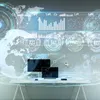Recalibrated workplace in a post pandemic world
Mahesh Nagaraj, Chief Marketing Officer, Microland, talks about how organisations are exploring and adopting several technology solutions to create safe and hygienic workplaces.
The pandemic world has impacted human consciousness at a level never seen before. This change is visible in the changes we see across the board on how enterprises and employees are viewing the new workplace. There is a complete spectrum of possibilities that companies are exploring on what the “new workplace” would look like.
At one end, there are enterprises who are intending to bring all their employees back to office and then there are others intending to bring back none. The answer will be somewhere along the spectrum, considering most of the businesses, like manufacturing, cannot just afford to work remotely.
Wherever an enterprise is positioned along this spectrum, it is clear that a “change” is in the air and the ‘recalibrated’ workplace will not be the same as pre-COVID. The pandemic has opened up possibilities which have not crossed the human mind. With this “art of the possible”, the human mind will now explore varied options and will adopt and adapt practices that will work best for the enterprise in “maximising profits”.
One of the key drivers will also be how employees and customers of organisations react to the situation. There are surveys showing that employees would prefer to have some kind of hybrid model of working but also at the same time, their expectation from their employers has also gone up to ensure there is a safe workplace.

Even if the workplace occupancy comes back to closer to pre-covid era, the workplace infrastructure will not be the same. There will be a combination of policy and technology changes that organisations will make not only to deal with the current pandemic but also with future pandemics.
Recalibrated workplaces
There is a new industry that is getting created arising out of the congruence of Smart Building, IoT and IT infrastructure. Enterprises are exploring and adopting several technology solutions to create safe and hygienic workplaces.
Digital Checks
Governments and enterprises are both exploring options of “immunity passports” to provide reassurance to allow people to enter establishments. While there are challenges in putting in a holistic solution, there are solutions being explored by different countries and at least 37 countries have launched contact tracing apps.
India’s Arogya Setu app has so far seen 150 million downloads. China has implemented a color-coding system by embedding QR codes in applications like Alipay and Wechat for entry into apartment complexes or markets.
Within the boundaries of an enterprise, voice activated wellness kiosks are being installed for employees to take wellness surveys and some of the kiosks like Clear Biometric kiosk in the future are expecting to connect to lab to validate results of their COVID test before entry
Companies in the western world are implementing contactless elevated body temperature checks before entry into offices. Surveillance companies are adopting thermal heat detection cameras to identify elevated body temperature. Similar repurposed solutions include face recognition companies launching mask and shield recognizing solutions.
Digital Entrances
A WhatsApp video of a Thailand mall installing foot operated lifts went viral. This is becoming mainstream as many companies are innovating contactless facilities entry solutions.
Otis elevators has launched an eCall app that one can use to call lifts using a smartphone. ThyssenKrupp has launched foot pedal operated lifts. There are companies exploring using ultrasound technologies for mid-air haptics instead of pressing on buttons.
Fingerprint based access control may die out, giving way to smartphone-based access control using Bluetooth, WiFi and NFC. This would be further enhanced by facial, iris or handwave technologies to improve speed and security. This would be applicable for every possible entrance, starting with turnstiles to accessing internal doors.
Optical turnstiles operated by barcodes are expected to replace the manual turnstiles. Doors that were operated by keypads, finger biometric readers and handles all need to be retrofitted in the new world. For non-secure spaces, doors could use handwave or sensor technologies which are already being used in airports, and hospitals, malls etc will start seeing more adoption.
There are several other solutions in the market including opening of doors by using a smartphone application. A building in New York City has implemented Openpath’s contactless solutions for stairwells, elevators and front doors. There are other companies that have come up with self-cleaning door handles. Many of these will start becoming mainstream in enterprises.
The most important part of any entrance is managing visitors. Preventing crowding and even limiting interaction at the waiting lobby will be the future.
Pre-registration of visitors will become a norm and even integrating them with wellness surveys and any other checks before approval will become the SOP.
It will become essential for people to print out badges at home before coming for meetings, like boarding passes. The process of providing physical temporary cards would be replaced with apps that provide timed passes activated on smartphone post self check-in on the app. Expect this to be accompanied with auto alert systems for the host.
Digital Workspaces
This is the crux of any working environment and the impact will be different depending on whether the space is a production floor or an office. There are standard changes every organisation is putting in place by trying to ensure seats are occupied by ensuring social distancing norms or by putting up partitions/ sneeze guards, equipping people with face shields, etc. Some companies have also asked their employees to ensure their desks do not have any personal items so that the cleaning can be made easier.
There are certain functions in any enterprise that will necessitate for its employees to come to office for performing their functions while there are functions which could be executed remotely. And the implications of changes are different.
There are a number of digital tracing and occupancy solutions in the marketplace like the ones from Microshare. There are wearables that are in the market like the necklace from Tharsus that sends out alerts to the employees when employees are in close proximity to others, violating social distancing norms. Samsung has introduced a social distancing application in its smartwatch.
For office-based activity, there is a need to start looking at areas with “smartdesks”. There are several companies providing a smart desk reservation software to schedule, reserve and manage employees who need to come into offices just a few hours a week. Just one of many such software which will make the transition easy.
Beyond smart desking the change required is the scheduling of the employees coming to the office and also how they follow “office lanes”. ServiceNow has come up with an application that enables employee scheduling, cleaning schedule post occupancy, etc.
Meetings rooms are also bound to change a lot. The easy part is the reservation. Where technology will play a key role going forward is in the introduction of voice activated intelligent assistants to control all the functions in the meeting rooms, including lighting and window screens.
One of the significant “high touch” surfaces are cables of all kinds, and meeting rooms will go cableless.
AR / VR technologies have not lived up to their expectations so far. This pandemic might just be the turning point. A number of companies have started adopting AR / VR technologies for remote expert guidance and training sessions.
Learning and training will be a new frontier that AR / VR might capture. Concerts and events have started adopting VR technologies. HTC recently did a complete product launch using VR technology.
Factory production floors will start seeing more automation and will give a fillip to Industry 4.0 initiatives. Machine to Machine collaboration creating a Digital Thread across all plant equipment / robots, 3D printing of parts, machine vision for audit and quality control, digitising data capture across all equipment, use of autonomous guided vehicles & drones are some of the technologies that will see significant adoption.
Digital Canteens
One of the high touch places in any office facility is canteens. This will need change not only in infrastructure, but also in behaviours.
Disposable cutlery and ultraviolet scan of finished food items will all come into play and can be immediately implemented, while some of the technology fusion might take a bit longer.
But companies like HungerBox are making progress by coming up with occupancy time wristbands, QR code for entry, and most importantly contactless payment using smartphone apps. There are some new emerging technologies which will take a while for adoption like voice activated microwave, smartapp operated coffee machines, sensor-based water dispensing machines and voice activated snack / food dispensing machines.
Chowbotics has introduced a salad dispensing machine to limit the length of the lines at the counter by making it self-service. The pandemic may also push the needle for portable food warmers because in the near term some of the enterprises may not be able to adopt several new equipment in their kitchen.
Digital Washrooms
Washrooms were already in the process of having technology infusion and some of them have to be redone. The hand dryer which found its position in many washrooms is now considered by health specialists as a potential distributor of bacteria and virus especially if the 20 second-hand washing rule is not followed.
Hand recognition or bluetooth based soap dispensers, paper towel dispensers, taps will become an essential part of every washroom.
Autonomous cleaning robots to ensure the floor is clean will start seeing adoption. A company called Somatic has a robot which cleans washrooms using virtual reality. Toilet occupancy indicators like in aircrafts will become necessary to prevent crowding of people in and at the entrance of toilets.
Digital Cleaning
Most enterprises used to schedule cleaning early in the morning or late in the evening or in some cases at a pre-defined slot within a day. This may have to change, and in alignment with shift schedules, to ensure that every time a new shift of workers comes in, the place is cleaned and this means the need for a suitable cleaning scheduling system. Finally, the builders and architects will look at the HVAC system and adopt Far-UVC technology for air purification.
In summary, while technology helps, any workplace recalibration is also about securing people’s trust so they feel that the workplace is safe to return.
Edited by Anju Narayanan
(Disclaimer: The views and opinions expressed in this article are those of the author and do not necessarily reflect the views of YourStory.)









